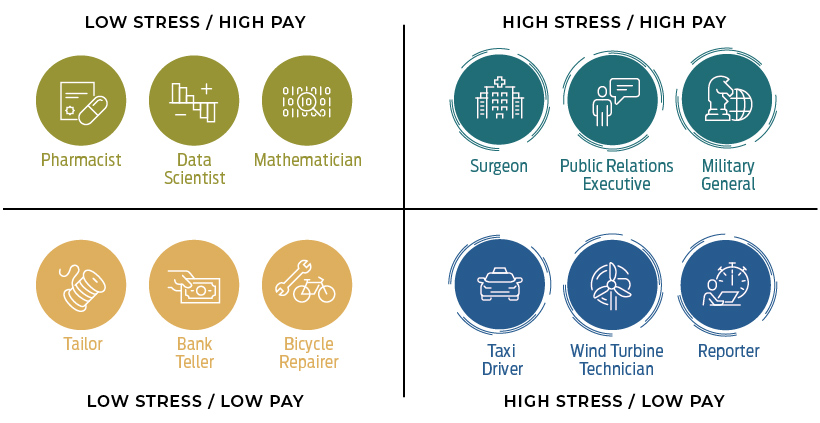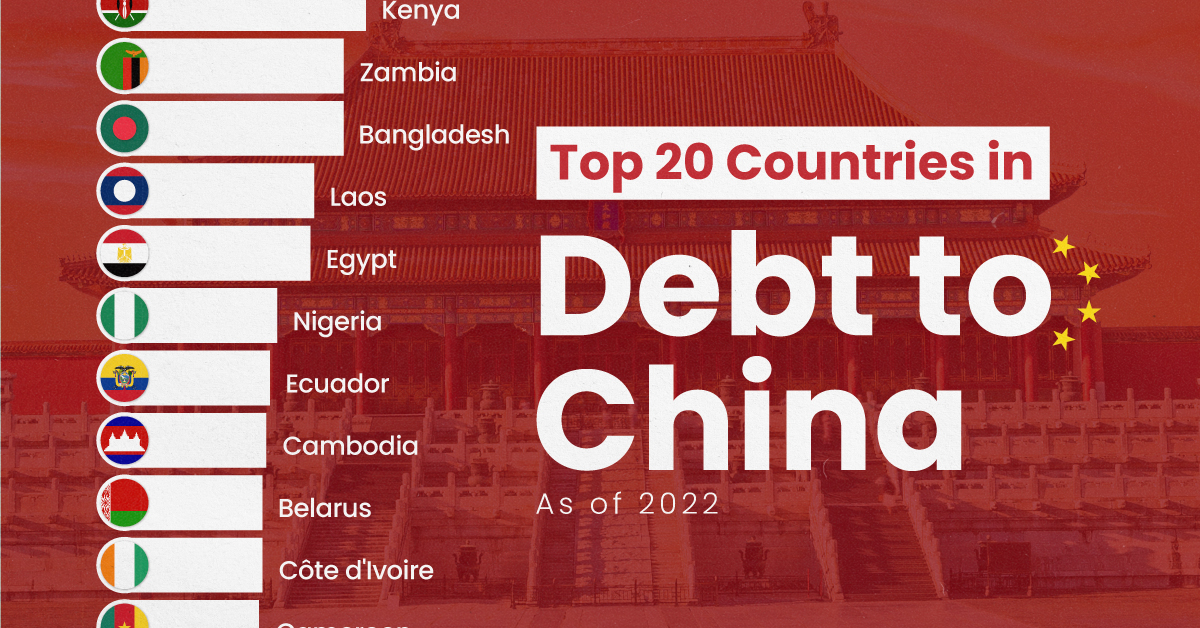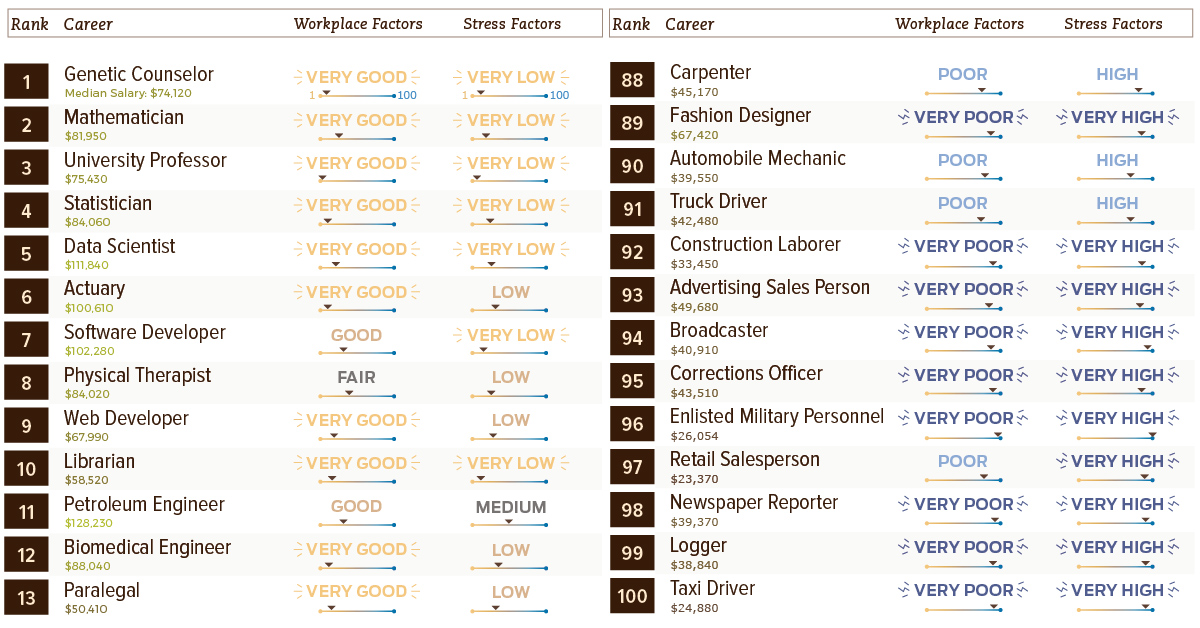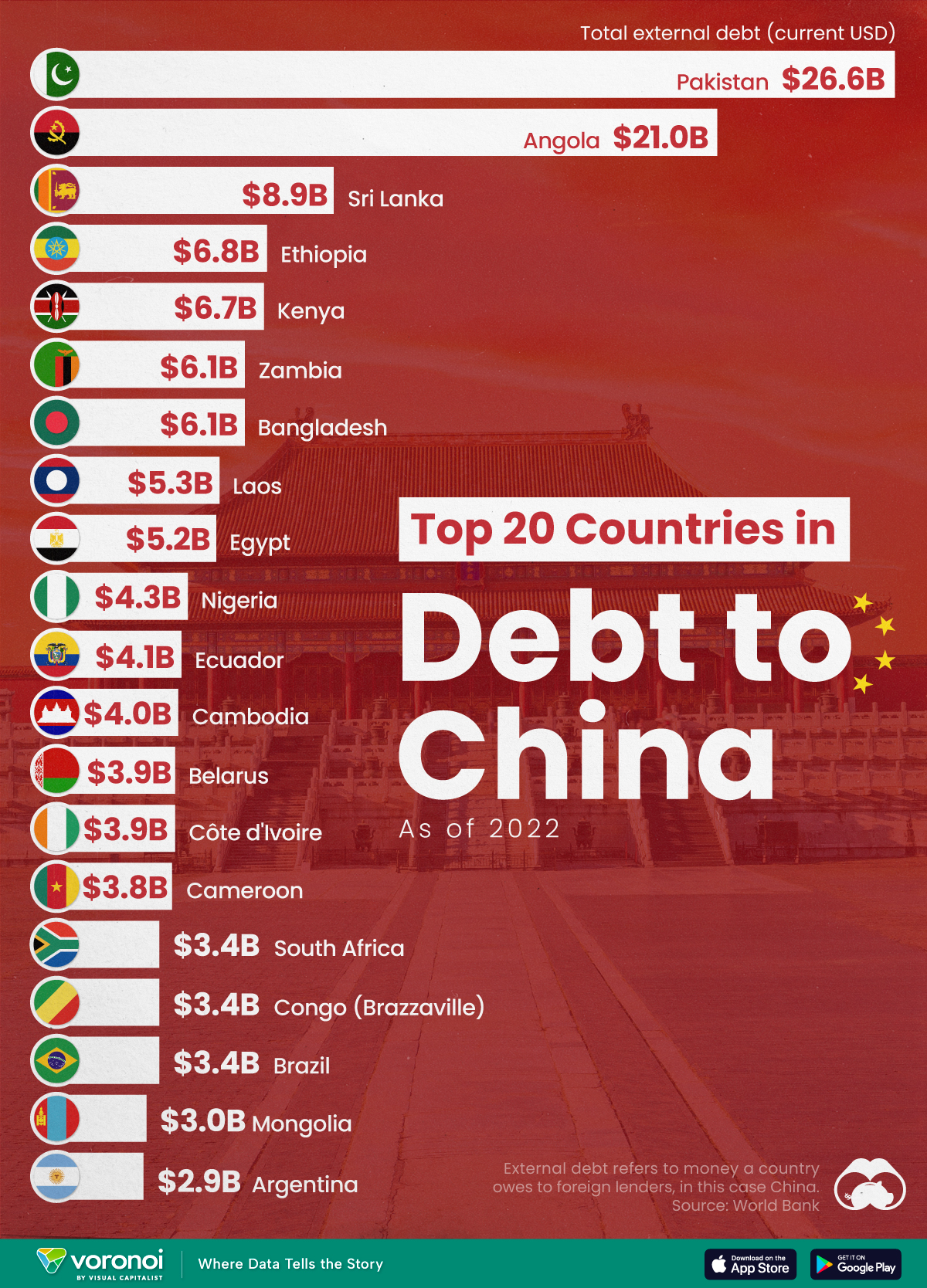Money
Visualizing the Ranking of 100 Common Careers
If you’re like most Americans, you probably spend more than 40 hours a week on the job.
For this reason, your career of choice plays a big role in determining your overall well-being. Not only does your profession have a massive influence on the potential money you make, but it also impacts your stress, work-life balance, happiness, and feeling of accomplishment.
However, it’s well-known that not all careers are created equally – and while some are stress-free with comfortable salaries, others can be high-stress without the compensation to make up for it.
Ranked: 100 Common Careers
Today’s chart uses data from the 2018 Jobs Rated Report by CareerCast.com, and we’ve used it to rank 100 of the most common careers based on median income, as well as three other categories: stress, growth outlook, and workplace environment.
The careers at the top of the list below have the best aggregate score, while the jobs towards the end of the list tend to be high-stress, low-income.

The 2018 Jobs Rated Report uses median income, as well as three other key categories to compile its rankings of common careers:
- Workplace:
A score based on the relative physical and mental demands for the job - Stress:
A weighting of 11 different stress factors, which range from “deadlines” to “own life at risk” - Growth Outlook:
Factors such as employment growth, income growth potential, and unemployment
See the full methodology here, for a more detailed explanation of the above categories.
Choosing the Optimal Career
If your goal is to maximize income, then traditional high-paying careers – like being a lawyer, doctor, investment banker, or senior corporate executive – are a good way to go.
For many people, however, a good career is defined as being more than just having high earning potential. Ideally, it’s also low-stress, while providing a healthy workplace that makes workers look forward to their jobs every day.
For people that think that way, it seems like being a pharmacist or a data scientist might present the best of both worlds:

At the same time, it may be safe to say that taxi drivers and reporters get the worst of both worlds: high stress and low pay.
Where does your occupation fall on the money/stress spectrum? Do you feel like the ranking above provides an accurate representation of your career?
Economy
Ranked: The Top 20 Countries in Debt to China
The 20 nations featured in this graphic each owe billions in debt to China, posing concerns for their economic future.

Ranked: The Top 20 Countries in Debt to China
This was originally posted on our Voronoi app. Download the app for free on iOS or Android and discover incredible data-driven charts from a variety of trusted sources.
In this graphic, we ranked the top 20 countries by their amount of debt to China. These figures are as of 2022, and come from the World Bank (accessed via Yahoo Finance).
The data used to make this graphic can be found in the table below.
| Country | Total external debt to China ($B) |
|---|---|
| 🇵🇰 Pakistan | $26.6 |
| 🇦🇴 Angola | $21.0 |
| 🇱🇰 Sri Lanka | $8.9 |
| 🇪🇹 Ethiopia | $6.8 |
| 🇰🇪 Kenya | $6.7 |
| 🇧🇩 Bangladesh | $6.1 |
| 🇿🇲 Zambia | $6.1 |
| 🇱🇦 Laos | $5.3 |
| 🇪🇬 Egypt | $5.2 |
| 🇳🇬 Nigeria | $4.3 |
| 🇪🇨 Ecuador | $4.1 |
| 🇰🇭 Cambodia | $4.0 |
| 🇨🇮 Côte d'Ivoire | $3.9 |
| 🇧🇾 Belarus | $3.9 |
| 🇨🇲 Cameroon | $3.8 |
| 🇧🇷 Brazil | $3.4 |
| 🇨🇬 Republic of the Congo | $3.4 |
| 🇿🇦 South Africa | $3.4 |
| 🇲🇳 Mongolia | $3.0 |
| 🇦🇷 Argentina | $2.9 |
This dataset highlights Pakistan and Angola as having the largest debts to China by a wide margin. Both countries have taken billions in loans from China for various infrastructure and energy projects.
Critically, both countries have also struggled to manage their debt burdens. In February 2024, China extended the maturity of a $2 billion loan to Pakistan.
Soon after in March 2024, Angola negotiated a lower monthly debt payment with its biggest Chinese creditor, China Development Bank (CDB).
Could China be in Trouble?
China has provided developing countries with over $1 trillion in committed funding through its Belt and Road Initiative (BRI), a massive economic development project aimed at enhancing trade between China and countries across Asia, Africa, and Europe.
Many believe that this lending spree could be an issue in the near future.
According to a 2023 report by AidData, 80% of these loans involve countries in financial distress, raising concerns about whether participating nations will ever be able to repay their debts.
While China claims the BRI is a driver of global development, critics in the West have long warned that the BRI employs debt-trap diplomacy, a tactic where one country uses loans to gain influence over another.
Editor’s note: The debt shown in this visualization focuses only on direct external debt, and does not include publicly-traded, liquid, debt securities like bonds. Furthermore, it’s worth noting the World Bank data excludes some countries with data accuracy or reporting issues, such as Venezuela.
Learn More About Debt from Visual Capitalist
If you enjoyed this post, check out our breakdown of $97 trillion in global government debt.
-

 Technology6 days ago
Technology6 days agoAll of the Grants Given by the U.S. CHIPS Act
-

 Uranium2 weeks ago
Uranium2 weeks agoThe World’s Biggest Nuclear Energy Producers
-

 Education2 weeks ago
Education2 weeks agoHow Hard Is It to Get Into an Ivy League School?
-

 Debt2 weeks ago
Debt2 weeks agoHow Debt-to-GDP Ratios Have Changed Since 2000
-

 Sports2 weeks ago
Sports2 weeks agoThe Highest Earning Athletes in Seven Professional Sports
-

 Science2 weeks ago
Science2 weeks agoVisualizing the Average Lifespans of Mammals
-

 Brands1 week ago
Brands1 week agoHow Tech Logos Have Evolved Over Time
-

 Energy1 week ago
Energy1 week agoRanked: The Top 10 EV Battery Manufacturers in 2023















